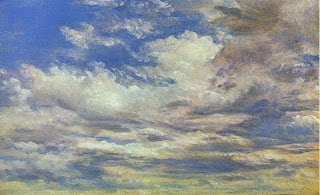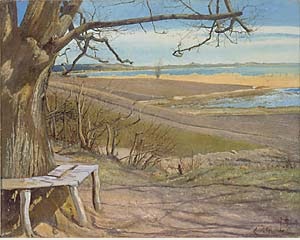I have commented recently about paintings framed under glass. The usual reason is because of the fragility of the paint surface. (In the case of Francis Bacon it was because of the distancing/dislocating/ ambiguities caused by reflections which he liked.)
In a recent show at the Laing there were paintings in oils under glass and there were two big acrylics likewise.That by Hockney and the similar sized work by Michael Andrews. Both were painted in the last 50 years and it must be presumed that they are under glass because they are fragile.One of the problems with acrylics has been their tendency towards softening and tackiness in a warm environment.Thus they are likely to acquire embedded dirt.Historically acrylics have been something of a problem to varnish. The problem at first was compounded by the poor quality of the varnish and by the fact that it is hard to discriminate between varnish and the paint-both having a similar vehicle.
To be fair I must say that there have been similar problems with oils where the components of the varnish may well be similar to the components of the binder/vehicle used in the painting.This makes restoring Old Master paintings a problem which requires considerable sensitivity.It has lead to controversy in many countries. The sins of restorers have been unending.The damage done in the past was extraordinary. Interfering with and experimenting on masterpieces has historically been, not exactly the norm but extremely common well into the C20.There is something about human nature which leads many to be unable to leave well alone. It happens in all areas of human activity-I'm thinking of fads in surgery: it certainly happens in the fine arts.
I suspect that the varnishes for acrylics have improved considerably over the years. Some can now be removed with mineral spirits-different from the binder so hopefully leading to less destructive interventions.
I have painted in acrylics myself but they are a mixed blessing for a landscape painter.Even in mild weather it is difficult to keep the painting from drying out.You can add retarder,you can spray your palette with water but the paint still hardens quickly.The pleasure of painting wet in wet is effectively denied to the artist working with acrylics.
In a recent show at the Laing there were paintings in oils under glass and there were two big acrylics likewise.That by Hockney and the similar sized work by Michael Andrews. Both were painted in the last 50 years and it must be presumed that they are under glass because they are fragile.One of the problems with acrylics has been their tendency towards softening and tackiness in a warm environment.Thus they are likely to acquire embedded dirt.Historically acrylics have been something of a problem to varnish. The problem at first was compounded by the poor quality of the varnish and by the fact that it is hard to discriminate between varnish and the paint-both having a similar vehicle.
To be fair I must say that there have been similar problems with oils where the components of the varnish may well be similar to the components of the binder/vehicle used in the painting.This makes restoring Old Master paintings a problem which requires considerable sensitivity.It has lead to controversy in many countries. The sins of restorers have been unending.The damage done in the past was extraordinary. Interfering with and experimenting on masterpieces has historically been, not exactly the norm but extremely common well into the C20.There is something about human nature which leads many to be unable to leave well alone. It happens in all areas of human activity-I'm thinking of fads in surgery: it certainly happens in the fine arts.
I suspect that the varnishes for acrylics have improved considerably over the years. Some can now be removed with mineral spirits-different from the binder so hopefully leading to less destructive interventions.
I have painted in acrylics myself but they are a mixed blessing for a landscape painter.Even in mild weather it is difficult to keep the painting from drying out.You can add retarder,you can spray your palette with water but the paint still hardens quickly.The pleasure of painting wet in wet is effectively denied to the artist working with acrylics.



